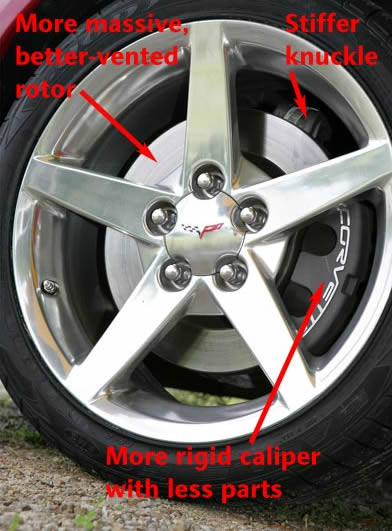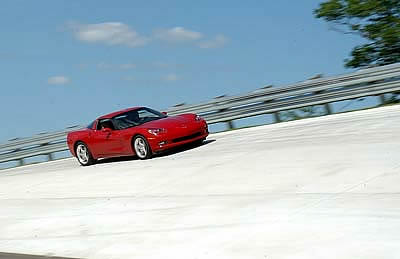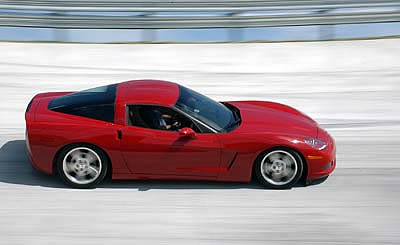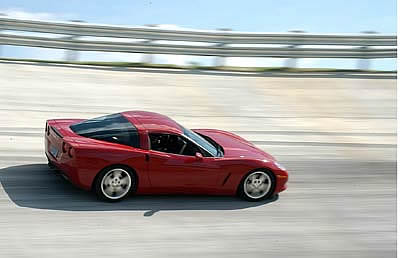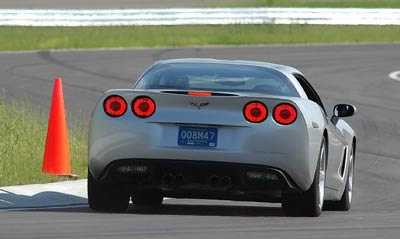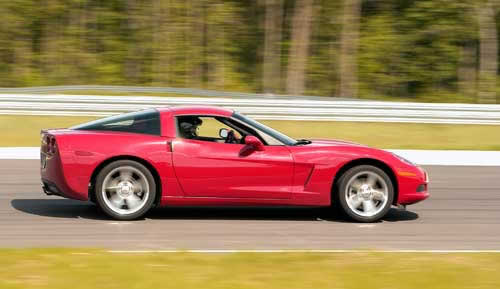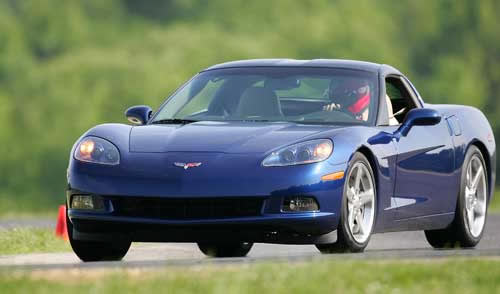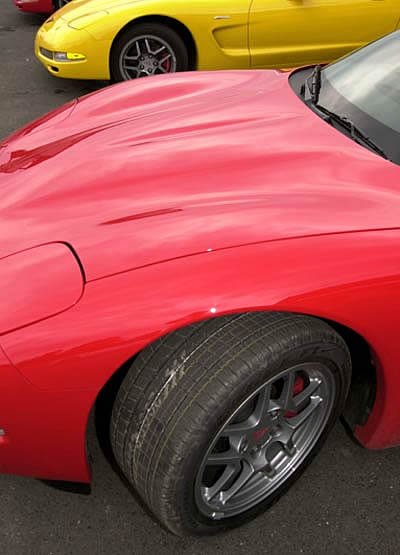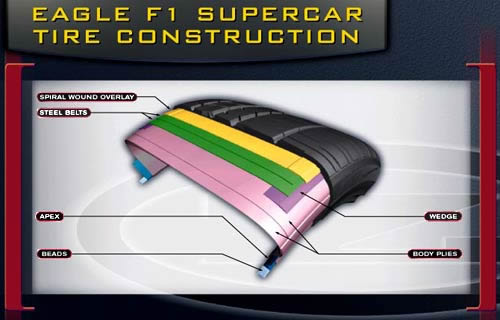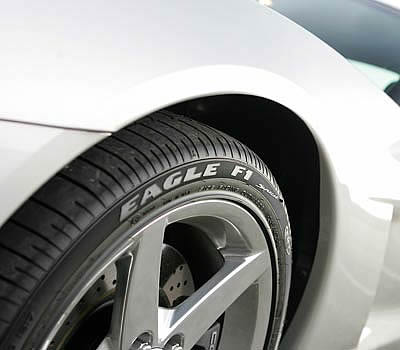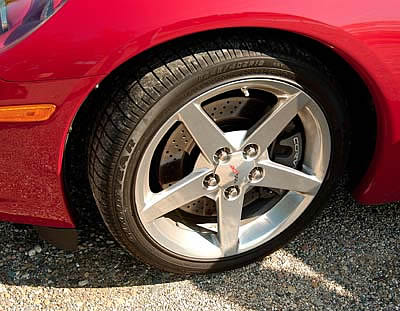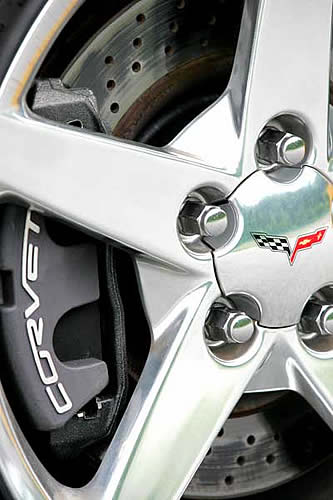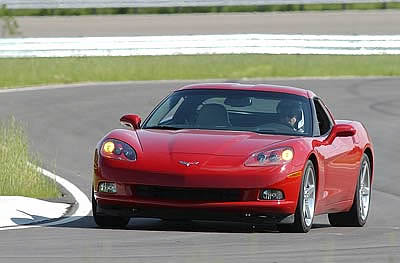C6, Naked and Exposed: Corvette Action Center's First Look at the 2005 Corvette - The Sequel: Finally, We Drive It! - Page 10 of 12
 |
 |
C6 Naked and Exposed - The Sequel: Finally...We Drive It!!! - Page 10 of 12
And, Talk to Some of the People who Built It
by Hib Halverson
Imagery by GM Communications, Richard Prince, U.S. Air Force and Sharkcom
©2005 Shark Communications
No use without permission
Stop to Match the Go: C6 Brake Upgrades
Brakes were a warranty problem on C5, especially in the first couple of model years when brake shudder due to brake rotors of questionable quality was fairly common. There were several part number changes for rotors in the '97-'99 period driven by GM's further development of brake rotors to address thickness variation, pedal pulsation and brake shudder most of which were due to heat cycling. According to GM documents, C5 ended its run with its highest warranty cost, on a proportionate basis, being brakes and we'll guess some of that money was paid-out to solve brake shudder problems. GM wanted to do something to further improve this situation with the 2005 C6.
First, brake rotors: they were redesigned with more mass, 1.5-lbs per rotor in the front and 0.9-lb. at the rear. Also, there is a revised hat section, thicker brake plates (the part of the rotor swept by the pads) and different venting. All of this combats thickness variation caused by heat cycling of the brakes along with reducing brake noise. Understand that, when brake engineers talk about thickness variation, they are thinking in ten-thousandths of an inch. It only takes a couple of thousandths of thickness variation to cause a serious brake shudder problem.
The rotor's hat section used to be a conical shape but now has a J-groove profile, a change intended to eliminate a type of rotor warpage called "coneing", which is when the brake plates warp radially into a slight cone shape. The brake plates are thicker for improved dimensional stability during heat cycling. The cooling vent design was changed from a curved-vane to pillar-post which enhances the rotor's ability to hold a consistent thickness during heat cycling and reduces noise. The rotors are made of a cast iron having a slighlty higher carbon content and this offers a slight improvment in damping which reduces brake noise.
C6 brake calipers are still made of aluminum and still have aluminum pistons, but otherwise are a new design which is stiffer across the bridge and have less parts for a more simple assembly having less brake drag.
The front and rear suspension knuckles or uprights were redesigned to make them more rigid. This reduces deflection of the knuckles under high braking loads such as comes when flogging a Z51 around a race track.
The master brake cylinder has been redesigned to make it more durable. The ABS/TCS/SES controller and modulator valve assembly both are new designs which are more quicker to respond and are designed for use with GM's LAN system rather than the old Class Two communications.
The Real Deal on the MRC
One reason the June 4th, media preview ended at Milford was to show we media folk a new facility at the "Grounds" intended for high-speed, chassis development, the "Milford Road Course" or "MRC".
When Bob Lutz came to GM as Vice Chairman of the Board for Product Development, GM was spending a ton of money shipping cars and engineers to Europe. To reduce cost, he thought the Corp needed a short version of Germany's famed Nurburgring test track. His idea was to build a track which would include the most useful and challenging vehicle dynamics situations Nurburgring presents to chassis development engineers. MRC doesn't replace all testing at "The 'Ring", but it is a substitute for a lot of it, making the development process quicker and less costly.
MRC cost several million dollars, took about a year to build and was designed in-house by Mike Neal and Jim Mero, two GM vehicle dynamics engineers with road racing experience, and Joe Ryan, a computer analysis expert. In addition two GM civil engineers, Larry Fielder and Dan Mulen, assisted on issues such as drainage, grades, construction and materials.
A great deal of computer analysis was involved to get the alignments and elevations of the track such that they'd make a severe test of suspension and braking, but not be so extreme that cars were forced off-course or would get airborne. In addition, to further prove MRC's layout, Neal, Ryan and Mero did a lot of "virtual driving" with a version of a popular auto racing computer game hacked to portray various MRC configurations. They, also, used a vehicle dynamics application which allowed simulation of a Z06 chassis driving a specific line on the track in real time and with full-motion graphics. All of this computer modeling helped make the track a high-speed, chassis development engineer's nirvana.
The course is 2.9 miles long, has 20 turns, a 135-ft. elevation change and, at the end of its longest straight, has Corvettes at the top of fourth gear, a little short of 150 mph. It's like no race track I'd ever seen nor is it supposed to be. Probably the most demanding aspect of the MRC is that every turn has both lateral acceleration and vertical acceleration so when you turn, the car is also getting heaved up or slammed down. What separates the really good chassis from the only-so-so ones is how they behave when they're turning, heaving and braking all at the same time. As the Corvettes of the 21-st Century continue to get better, it will be, in part, because of the MRC.
Most race cars probably couldn't run on the Milford Road Course without damaging some of their air dams or undertrays. Even if race cars could run on this track, no races would happen there because it's not designed for wheel-to-wheel competition with passing. MRC is for testing of road cars and is the most "technical" track I've ever driven-or probably ever will drive. It's so tough to learn that the 10 laps GM gave me only had me mastering the easiest sections enough that I felt comfortable running a C6 through them at its handling limit.
A novel and most unforgettable feature of the MRC is the sixth turn. Everyone calls it "The Toilet Bowl" because it's an all-concrete, high-banked, tight-radius, 180° turn intended to maximize suspension loading to see how the chassis works when near or on the bump stops. The first time I did the Toilet Bowl at speed, I thought of the F/A-22 and what it must be like when a Raptor driver slams the sidestick over and back for a very tight, high speed turn.
Scream though the Toilet Bowl and the g-forces with vectors never experienced in street driving are more akin to a theme park thrill ride. Once the novelty wore off and I began to run its high banking with some speeds near what Neal, Mero and Ryan intended, I found: sure enough, C6 has more ride travel and it's not on the bump stops as much as was C5-of which there were several examples (including a sister to my own Z06/Z16) to drive in comparison.
In a "more conventional" at-limit environment-ie: outside of the toilet bowl-there other characteristics I felt as I thrashed C6es which indicated the '05 chassis is improved. First, corner entry was more refined. C5 was damn good at the limit, going into turns, but it was sometimes a tiny bit on the oversteer side-not like you were going to lose it or anything like that; just not quite tail-in to the point of perfection. Consequently, it was never very easy to trail brake a C5-not that that was the quick way around a turn, of course.
C6 in corner entry, especially under braking, is more tail-in. Plus, if you're on a rough or undulating surface while braking, it's less likely to touch the front jounce bumpers which keeps the front end securely planted on your line. Lastly, the car's better manners going into a turn has the driver working a little less hard and, because smooth is fast; your section times will be better. This more settled behavior on corner entries comes from the increased ride travel with shock valving to match, the significant improvement in the Goodyear F1 GS-2 and the increased pre-load in the limited slip differential.
In the midpoint of a turn, even with base and F55 suspensions, because you have more grip from the third generation EMTs and more roll stiffness from bigger stabilizer bars than were on C5; the car's lateral grip increases. Even the base car will do 0.92g. Plus, as you transition from corner entry in a more balanced condition, you're not confronted with having to calm a slightly-iffy-at-the-limit car near the apex. In turns with dips, swales or bumps, the car feels more poised, mainly because of the extra travel and the changes in shock valving-in short, even at the limit; the car rides better.
Off turns, C6 gets its additional torque and horsepower down quite well. The key enabler of that is the increased suspension travel, more compliant tires and revised shock valving. Also, playing a part in the car's corner exit demeanor is the improvement in balance earlier in the turn, that is: if you come in a little less tail-out, do the center of the turn, also, with a little more finesse; then that smoothness carries into the exit giving you a faster speed out of turns.
The 2005 Corvette's at-limit-handing improves incrementally and is more easy to manage. In fact, some might be disbelieving, but I think base C6es are a bit quicker around many tracks than C5 Z51s. Plus, you look a little better and are more comfortable while being just that little bit quicker. C6 is a blast to drive fast and, to have that much fun; you don't have to work as hard.
Z51 gets an A+
Up to now, what we've said about how C6 drives applies to all the 05s, but there are some aspects of the Z51s which deserve specific coverage. One fact is clear: the march of technology has allowed GM to evolve the Z51 such that, performance-wise, it's quite a bit beyond the C5 Z51 option. In fact, it's two-thirds, maybe even three-quarters, of the way to where the '04 Z06 is, now, and it makes that approach to C5-Z06-class performance in a quieter and nicer-riding manner.
Like 1997-2004, the C6 Z51 option includes higher-rate springs, higher-rate antiroll bars and larger-diameter, more stiffly-valved shocks. All those items help make the Z51 more of an aggressive driver's car, however, the biggest contributor to the revised Z51's, almost-a-Z06-handling, is the new Goodyear F1 Supercar EMT tire. In a nutshell, it's the original Z06 tire with: slightly more tread depth, slightly less tread width and the more compliant 3rd Gen. EMT casing. "That is pretty much the the case," Nick Hill states. "It was given what we call 'more non-skid'-deeper grooves to aid the evacuation of water because the (C5) Z06 (tire) had very shallow grooves and was meant for out-and-out, dry performance and we wanted more wet performance from the C6 FE3 level tires."
"We did a lot of computer modeling with the mold shape and cavity shape. Also, the tread pattern was refined and improved to try and stay close to the level of dry handling of the C5 Z06, but, at the same time, get much better wet handling and, if we could, a softer ride and less noise. All that work was put into the new Supercar tire for the C6, plus-we went to a different size than the Z06 tire."
In talking the Mike Neal and the guys from Goodyear, we were amazed to hear some of the extremes to which the tire development team went to get the F1 Supercar EMT right. As long as the car's setup is ok, most of us who autocross or do track-day types of road race events don't worry about tire wear that much. Most of us know that if we race, our tires will wear much quicker and perhaps not in the way we expected. Nevertheless GM and Goodyear spent some time making sure the Z51's tires would wear consistently across the tread.
"In early tests of the FE3 rear tire," Nick Hill went on, "we (GM and Goodyear) got the lap times and the consistency we wanted, but we got an odd kind of chamfer wear on the second rib in from the inner shoulder. It didn't affect performance, but it just didn't look great."
"We said, 'Well, hey, it's not affecting your lap times.' but Mike said, 'I know, but when a customer sees that, they think there's something wrong. They think maybe the alignment's wrong or there's something else wrong with their car.'
"And it did look odd. Most of the blocks wore flat, but then you came to the second one in, it has this, like-30 degree angle of wear across it and, then, the outside rib was fine. It must just have been how the contact patch, where all the work was going into the tire as you cornered, reacted. It only happened in track work. It happened at Virginia International Raceway, Grattan and, to some extent, Nurburgring.
"Mike said that he wanted that fixed, so we did another mold that basically closed-up the inner groove and changed some angles of the groove. That fixed the uneven wear. So now, no matter how many laps you do, the tire is, more-or-less, flat across the whole tread. There's no ribs that have been worn with an odd chamfer.
"GM wanted the FE3 tire to be a substantially better performer than the FE1 tire because they wanted the Z51 to go faster, do quicker lap times...they really wanted to differentiate between the two vehicles, handling-wise.
"The problem, from our point-of-view, was we were using the same sized tire for FE1 and FE3, so we had to get all that extra cornering power through the construction, tread pattern and compounds so that Mike could get the better lap times with the same size contact patch. In the end, we went to Grattan, did back-to-back timed laps against a C5 Z06 and we got exactly the lap times and lateral acceleration that Dave Hill had tasked Mike with getting.
"I think GM was pretty happy," Goodyear's Nick Hill states proudly, "with where they ended up with the F1 Supercar EMT."
Unlike C5, Z51's get a special set of brakes, consisting of larger diameter rotors with curved vane venting and cross drilling. Z51 rotors use the more common curved-vane vents because they're better for cooling. Also, a different, more aggressive pad material is used, front and rear. The new pads are more tolerant of small thickness variations and that compensates for not using pillar-post venting. The pad material was chosen for compatibility with the drilled rotors, ie: to avoid what brake engineers call the "cheese grater effect" on pad wear. The more aggressive pad may make a little more noise, but, GM logically figures Z51 owners, the more sporting drivers that they are, will accept that along with better brake performance during aggressive driving. The rear brake calipers on Z51s have different pistons which are 4mm smaller in diameter. That makes brake bias more optimal for brake pedal feel during aggressive driving maneuvers because there is less ABS intervention and less dynamic rear proportioning (DRP) action to degrade the consistency of pedal feel. The smaller pistons also decrease rear brake pad wear compared to the front, but the differences in pad wear rates was deemed an acceptable compromise for better brake feel during at-limit handling situations.
The combination of all this chassis stuff makes for nearly a full-tenth of a g improvement in max. lat. from about .90g, for the base C6, to about .99g. In addition, extra ride travel keeps the car off the jounce bumpers and makes driving a Z51 at the ragged edge a less ragged experience. The brake system improvements won't be noticed on the street-well except for maybe the cute, drilled rotors-but on the track, especially in situations where you're doing laps in succession, the car stops better and more consistently as heat builds in the system.
A common question will be: how does a C6 Z51 compare to a C5 Z06. Well, on the MRC, you can drive an '04 Z06 to incrementally quicker times, but to do that requires a lot of attention, ie: you've got to be right on-top of the car when it's at its limit. The Z06 is quicker via lighter weight, slightly more roll stiffness and marginally wider tires. The 2005 Z51, manual, over the same course, is not quite as quick, but can be driven to its limits with less effort. I clearly understood what Mike Neal was saying when he told me, "The huge thing with the new Z51 is handling. I mean, you are not all the way to a Z06; but you're darn close."
As with C5, the Z51 option is available on both models, with either manual or automatic transmission and with all of the C6's comfort and convenience options except MagnaRide. Who should buy Z51's? The answer might surprise you. If cars with base and F55 are for entry level Corvetters and those who like a touring style of driving-maybe they're too poor to buy a Cadillac XLR-and if Z06es are for "the extreme motorsports enthusiast" as Chief Engineer, David Hill, is fond of saying; then Z51 is for everybody in between for the aggressive street driver, for the occasional autocross or track day driver who also takes the car to work, for the daily commuter who lusts for the sporting nature of America's Sports Car or even the wannabe who has gotta have the cross-drilled rotors and the F1 Supercars 'cause they look cool, but orders an automatic, heated seats and doesn't want anything close to a stiff ride. That is a distinctly different situation from C5, where Z51 was marketed as a motorsports option and dealers discouraged people from buying it because of a perceived stiff ride.
"People shouldn't be afraid to order the new Z51, because they believe it will be too brutal," Mike Neal said in closing. " It's really a much nicer riding car than before. Most people who have even a limited desire for sporting driving will enjoy it."
After driving base and Z51 C6es on the street and the track, I concur. Z51's handling is definitely more sporting and, as a Z06 owner, I can attest to its handing being at least 2/3rds of the way to the C5-Z06-class. In fact, my frearless forecast is that GM better have ordered a ton of Z51 parts because I think a lot more Z51s will be sold in the C6 era and Bowling Green will need a lot of pieces to build those cars.
I think its ride is only incrementally more firm than the base model C6 but here's the amazing thing: judged subjectively; I think the C6 Z51's ride is about as soft and maybe even a bit more poised than was the C5 base suspension because body motions are less severe and the suspension is not on the jounce bumpers as much. I know this sounds a bit like GM spin, but once the C6es get out there, my guess is the early owners' comments may confirm this.
Almost a Z06. Easier to drive fast. Almost the same power. More torque, More refined. Same mileage. Better looking. All at a lower price.
What's not to like!?
We give it an A+.
 |
 |
